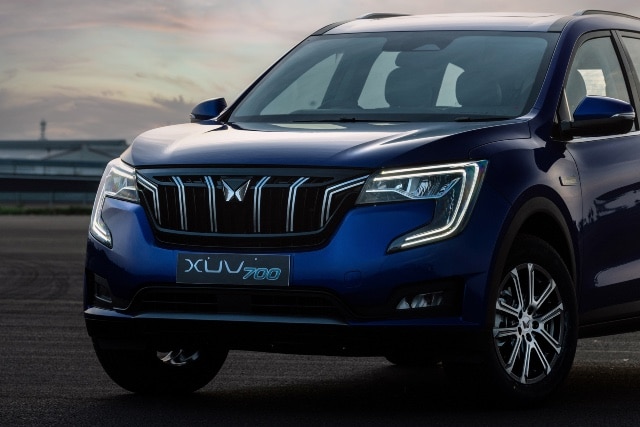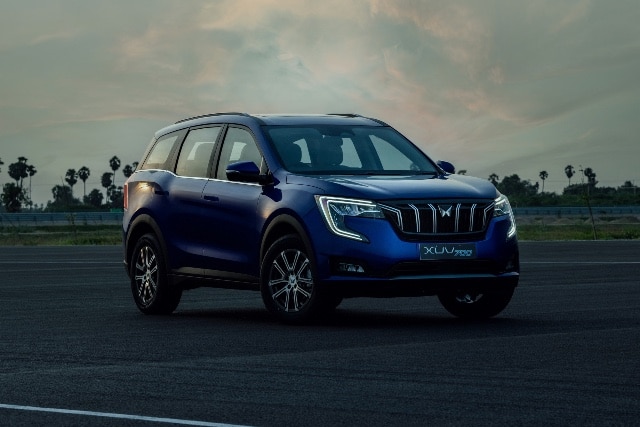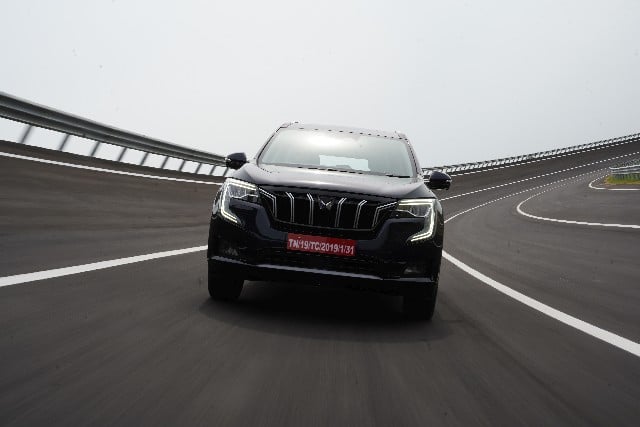We’ve just driven the new Mahindra XUV700 at the brand-new Mahindra SUV Proving Track near Chennai and here’s our first drive review in nine simple points.
[metaslider id=30563]
1. Mahindra XUV7000: Design
The XUV700 remains true to the Mahindra XUV500 design, only taking it forward. In the flesh, the Mahindra has a strong presence and a proper SUV stance which leaves an impression. The highlight is the large front grille with vertical slats, and it’s been seen for the first time on the recently unveiled ‘Twin Peaks’ logo. And this will now be a regular feature on all future Mahindra SUVs. Sequential turn indicators, flush-finish door handles to improve aerodynamics, LED fog lamps and cornering lights all help improve the value proposition. But not all are in proportion. For instance, the new LED headlamps’ sabre-tooth DRLs seem exaggerated, the 18-inch alloys don’t fill up the carved out wheel arches quite well, and the ‘Arrowhead’ tail lamps look overdone to my eyes. But for most of the target audience, the flashy design elements will definitely flatter the sheer road presence.
2. Mahindra XUV7000: New Platform
There’s a reason why this is called the XUV700 and not the 2021 XUV500. Underpinning it is a new platform which not just supports all-wheel-drive options but has been designed keeping future mild-hybrid powertrains in mind. The wheelbase is 50 mm longer, and overall length has gone up by 110 mm. And to aid dynamics and CG, it’s 30 mm lower now. There’s a whole list of segment first features and brand-new engine options – a 2.2-litre mHawk diesel and mStallion 2.0 turbo-petrol. These had first made their debut on the Thar but makes more power here. (Also Read: Mahindra Bolero Neo Review)
3. Mahindra XUV7000: Cabin
As you get in, you are greeted with an elegant looking dashboard. Some of the design elements are heavily inspired by Mercedes-Benz. Like the long display covering practically half of the dashboard. These are essentially two 10.25-inch screens — a central infotainment touchscreen sitting next to the large driver’s information console. Since this piece of tech is standard in practically all the trim (except the base), it definitely will be one of the key attractions for buyers. The only drawback here is the unfriendly user interface of the infotainment system. The other luxury-car inspiration is the layout of the power seat buttons and location on the door panel.
Unlike some competitors who offer touch-sensitive a-c controls, Mahindra have kept things old-school and offer the usual buttons and dials. There’s even a rotary dial on the centre console for easy access to the infotainment and car settings. And you even get dedicated buttons for a few key features. There’s a decent number of cubby holes, thankfully two dedicated mobile phone docks, sliding front armrest with cooled storage. The overall finish, quality of plastic and beige leather does meet the segment standards, though the faux wood plastic on the door panel looks plain tacky, just like the glossy piano accents.
4. Mahindra XUV7000: Features
Mahindra are betting big on the XUV700 and understandably have included all the features offered by competition like the Alcazar, Hector Plus and Safari, among others. In this segment, it’s incredible to see luxury car like features such as driver’s seats with memory function seats that retract to welcome you, dual zone climate control and seven airbags. The biggest talking points are the ADAS (Advanced Driver Assistance System) technologies which use radar and camera to offer front collision warnings and auto emergency braking, lane departure warning, lane keep assist, adaptive cruise control and smart pilot assist. In the limited time we got, most of these worked as promised though it takes a little time getting used to these futuristic tech. There’s the industry standard kits too — including a large sunroof which can be controlled by voice commands, a Sony 12-speaker music system, in-built Alexa and app with zillions of functions, and wireless connectivity for Android Auto and Apple CarPlay. Not to mention, 360-degree view, blind spot monitoring, wireless charging and so on. Greedy as we are, we would have loved to see ventilated seats on such a feature-rich car.
5. Mahindra XUV7000: Seven Seat Comfort
The new platform has helped carve out more useful cabin room making it almost as spacious as the Tata Safari. Mahindra will be offering the XUV700 in five and seven seat options, and we got our hands on the latter. The front seats are large enough and offer good support and have decent elbow room. Fine tuning the driving position is easier on the top-end AX7 variant, which gets steering adjustment for reach, apart from the standard tilt. They’re comfy enough and it comes from personal experience here. Thankfully, Mahindra Eva worked to improve the overall ergonomics but there are some minor niggles like the rotary dial is a little far-back on the centre console, just like the power window switches. And when I got to drive the manual version, the gear lever position also had a similar issue.
The XUV700 is wide enough to seat three in the middle road. Though the seats are comfortable with decent room, it could do with some more thigh support. From here, passengers get the convenience to slide forward the front passenger seat. Surprisingly the second row doesn’t slide which leaves limited adjustability for the third row. The second row has a one-touch tumble function, but ingress and egress to the last row is a task. Space in the third row is restrained with limited knee- and headroom. Thankfully, you get dedicated a-c vents and a large glass area. The last-row can also be reclined for added comfort but the adjuster is behind the backrest which is difficult to reach. Right at the back there’s little luggage room, but once the third row is folded the storage area becomes large enough. Meanwhile, the spare wheel is located under the car which can be tricky to dismantle for the uninitiated.

6. Mahindra XUV7000: Petrol Engine
Mahindra have really hit it out of the park when it comes to outright performance. We sampled both the petrol and diesel versions at Mahindra’s swanky, new SUV proving track which is spread over 454 acres just outside Chennai. Both the engines are offered with the option of a six-speed manual and six-speed automatic transmission, but we couldn’t wait to put down the spectacular 200 hp of the ‘mStallion’ 2.0-litre turbo-petrol on the smooth tarmac of the track. This is the most powerful petrol engine of its class, and the numbers translate on ground too. Press hard on the accelerator and the XUV700 surges ahead riding on the strong power band right from the start. Even in the automatic avatar, the engine doesn’t shy away from being revved hard to deliver a thrilling performance. For an almost 2 tonne SUV it feels surprisingly quick to reach 100 km/h and we won’t be surprised if it does that in sub-10 seconds.
The only hitch here is the six-speed automatic which doesn’t feel as quick as some of its competitors when driven hard. But if you keep at it, the Mahindra charges ahead relentlessly to higher three digit speeds. In fact, we had to control ourselves not to go overboard with this peppy engine. And it’s not just about top-end, as the 380 Nm of torque comes in at just 1,750 rpm making it feels light on its feet even at lower speeds. At city pace, the automatic shifts feel adequate and relaxed, and the petrol engine is very refined with barely any NVH. Moreover, it also promises to be one of the most fuel efficient petrols in its class which should make this version a popular choice.
7. Mahindra XUV7000: Diesel Engine
We also got a short drive in the 2.2-litre mHawk diesel that produces 185 hp which, like its petrol sibling, dons the crown of being the most powerful in its class. There’s also the 155 hp, 360 Nm tuned version which powers the base variant and is only offered with a six-speed manual ’box option, which we hope to drive on at a later date. Our more powerful test car remained fairly refined at lower revs but the usual diesel gruffness can be heard beyond 2,500 rpm. After the initial turbo-lag, the diesel XUV700 springs to action and there’s plenty of performance in store. There’s seamless power delivery and loads of torque around 1,600 rpm which give it great low speed tractability, and in turn leads to spirited performance. Overtaking is made easy and even light taps on the accelerator makes this diesel spin up. The manual gear shifts have the usual SUV-like throws and the clutch action is pretty light. The oil-burner also gets driving modes —Zip, Zap and Zoom, which the petrol version misses. Zip restrains the power to deliver a more relaxed drive, Zoom squeezes the max out of the engine and makes the acceleration more intuitive, while Zap lies somewhere in between. At city and basic highway speeds, the cabin remains well insulated and free from wind, engine or tyre noise.
8. Mahindra XUV7000: Ride and Handling
Speaking of which, we got to take the XUV700 over some tricky obstacle course to understand its off-roading ability, over some unpaved roads to experience the ride and on fast-paced corners to get a glimpse of its ride and handling prowess. The dynamics is leaps and bounds ahead of the outgoing XUV500. The credit for this goes to the independent MacPherson struts with FSD dampers and improved anti-roll bar at the front, and an independent multi-link layout with control arms and an anti-roll bar at the rear. At highway speeds it absorbs road undulations with aplomb and feels pretty planted. It might feel slightly firm at city speeds especially over sharp joints and larger potholes. Overall, the ride is not as plush as some of its rivals.
The well-tuned suspension, along with the stiffer chassis and a quick steering make the XUV700 feel lighter and more compact than it actually is. The electric power steering feels light at lower speeds which allows you to turn into the tightest spots without effort. As you go faster there’s decent feedback and there is ample communication even when going off-roads. Our test car’s MRF tyres also offered good grip on these varying conditions and even when cornering sharply. Though, hitting the apex enthusiastically did make our two-wheel-drive XUV700 understeer. And since it’s a tall car with a high centre of gravity, there’s evident body roll when pacing through corners.

9. Mahindra XUV7000: Conclusion
With the XUV700, Mahindra are regrouping their resources to reestablish themselves as the SUV masters of India. Which explains the shocking starting price of Rs 12 lakh. They haven’t announced what the top-end AX7 we drove will cost but it should be closer to Rs 20 lakh (all ex-showroom prices). With two strong engine options, a comfortable cabin, more than plenty of features including the segment-first ADAS tech and ample bling for the TG, purely as a value proposition, the XUV700 is hard to ignore.






















Leave a Reply